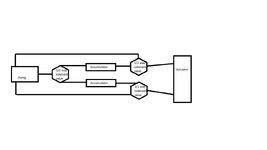AutoStudent25
Student
- Mar 13, 2025
- 6
Hi, I am currently working on a project at Uni that involves coming up with an ECS for an adaptive rear wing system. I plan on using hydraulics due to their fast response time, I want to set up a pump attached to two accumulators which in turn are each connected to a solenoid valve and the linear hydraulic actuator at the start of one accumulator will be empty and the actuators top chamber full when the wing is required to tilt the full accumulator will empty into the bottom chamber forcing the fluid in the upper chamber back into the empty accumulator beginning a cycle in which the fluid is forced into accumulators from the actuator conserving energy. excess fluid from filling the actuator is rerouted with the solenoid valve to the pump where it is routed using a solenoid valve to whichever accumulator will be filled next cycle. W
Will This concept work and what are things I should tweak?

Will This concept work and what are things I should tweak?
